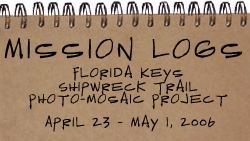|
 |
| |
Mission Logs
 April 30, 2006 April 30, 2006
Crunching data, wrapping up and heading home.
 April 29, 2006 April 29, 2006
Rough seas and small craft advisories make the going tough.
 April 28, 2006 April 28, 2006
The team explores the North America, a 19th century masted vessel.
 April 27, 2006 April 27, 2006
Today kicked off media day as the team provides an educational tour under water.
 April 26, 2006 April 26, 2006
Archaeologists kick off the photo-mosaic mission. Take a look at the newly developed sled technology in action!
Mission Home Page
|
|
|
|
Mission Log: April 26, 2006
The photo-mosaic technique has evolved into a highly accurate supplement to the shipwreck site documentation process. And now Tane Casserley, a maritime archaeologist with the National Marine Sanctuary Program's Maritime Heritage Program, has added to this technique's precision by developing a propulsion sled that assists in more accurately capturing photo-mosaics.
 |
| Click image for caption and full view. |
The photo-mosaic technique initially began as a way to simplify documenting deep-water shipwrecks, but its usage has grown far beyond that. The process involves a two-man dive team. One diver operates a DPV and tows another diver behind him. That diver has a video camera pointed straight down at the shipwreck and uses a bubble level to keep the camera aimed downward. Both divers also wear depth gauges, which they use to maintain a pre-arranged depth during the survey. Once back on the surface, computer software is used to pull still frames from the video which are then overlaid one by one to create an overall photo-mosaic of the site.
While this generally produced an image of an entire shipwreck site, there were scaling problems if the shipwreck had differing levels of relief. To overcome this problem and to produce a more accurate photo-mosaic, SONAR depth sounding devices were attached to both the DPV and the video camera. The SONAR bounced sound waves off the bottom topography, i.e. the deck of a shipwreck, and the reflected sound waves were interpreted as a numeric readout in feet on the SONAR device. This insured that the camera remained a consistent height off the shipwreck and produced an accurate scaled photo-mosaic of the site below.
Incorporating SONAR into the process has yielded five extremely accurate scaled shipwreck photo-mosaics including the steamer Queen of Nassau in the Florida Keys National Marine Sanctuary and the schooner E.B. Allen, the unidentified schooner known as Target 7, the steamer Pewabic, and the schooner Cornelia B. Windiate in the Thunder Bay National Marine Sanctuary.
 |
| Equipment being used on the photo-mosaic mission. |
Building on this success, the photo-mosaic technique is evolving again. Using a larger system on this mission, divers will no longer be towed, but will ride together on a sled straddled by two DPVs. This new method will attach the SONAR to the sled by adjustable arms and it will also attach the video camera to the sled with a downward facing ball mount. Now both divers ride side-by-side with one diver operating the camera and the other driving the DPV sled. This technique will not only provide a much more stable and controlled video platform, it will also provide a rigid structure to attach lights and other equipment that will aid in the documentation process.
|



